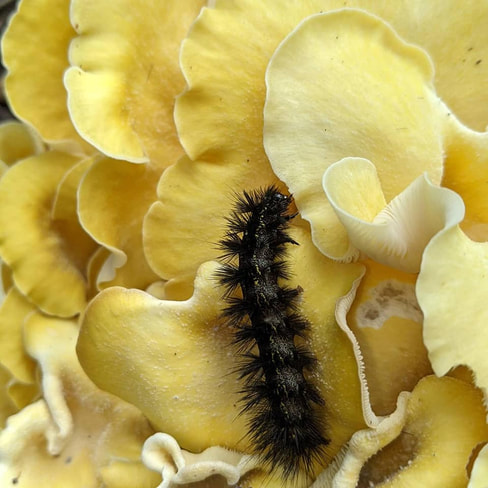 I captured this caterpillar chilling on golden oysters growing at Zilker Botanical Garden in our strawberry and asparagus, mushroom garden bed. I did a quick iNaturalist search to learn it is a Salt Marsh Moth, Estigmene acrea. This app is a great tool for researching and identifying good and bad insects. You can see multiple pictures of insects at their various stages of life, and descriptions from Wikipedia. It even gives you a breakdown of where else insects have been observed in your area on a map. The caterpillar is beautiful as a moth, and as a growing caterpillar clearly had an appetite for nitrogen rich vegetables. They were also devouring the leaves of the fava beans that were nearby. We contemplated why one of the caterpillars was a fungivore. Definitely has good tastes. This lucky caterpillar struck gold in finding an even more appetizing meal. We decided to allow these caterpillars to continue to enjoy their meal. Learn more about how to grow mushrooms in the garden here. From Texas A&M:
Despite the name, salt marsh caterpillars can show up in many different habitats other than salt marshes. They eat a wide variety of plants and are found all across the United States. In some places, like southwest United States, these caterpillars can damage crops. Salt marsh caterpillars skeletonize the plants they feed on, leaving only the main leaf veins. Older caterpillars eat large holes in the leaves and become more solitary. They can go great distances in search for food and can sometimes travel in large numbers. Salt marsh caterpillars do not bite and are not poisonous. Related: Don’t miss our next online guest, Jay White, the publisher of Texas Gardener Magazine who will be presenting more on this topic with his “Pest-free Organically” presentation on May 10th at 6 PM CST. |
AuthorWrite something about yourself. No need to be fancy, just an overview. Archives
May 2024
Categories |




 RSS Feed
RSS Feed